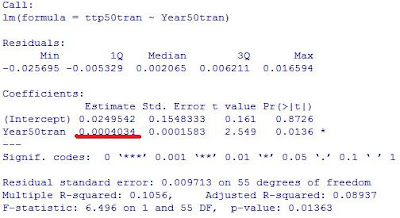WAR has an R^2 of .83, but what does that really mean? Some context (all stats from ESPN.com):
ALwins ALera ALba ALops ALrbi
ALwins 1.000 -0.642 0.588 0.704 0.672
That is how American League wins correlates (little "r" not R^2) with ERA, Batting Average, OPS, and RBI. And the NL:
NLwins NLera NLba NLops NLrbi
NLwins 1.000 -0.751 0.369 0.503 0.572
I made three linear models for each league to find the R^2 of wins versus ERA and BA, ERA and RBI, and ERA and RBI. The R^2 values are .84, .86, and .87 respectively for the AL. For the NL .61, .82, and .81. Below are the print outs from R.
Call:
lm(formula = ALwins ~ ALera + ALba)
Residuals:
Min 1Q Median 3Q Max
-7.6862 -2.7943 -0.7403 1.9202 9.0998
Coefficients:
Estimate Std. Error t value Pr(>|t|)
(Intercept) -49.532 46.485 -1.066 0.309461
ALera -24.762 4.224 -5.862 0.000109 ***
ALba 907.270 166.522 5.448 0.000201 ***
---
Signif. codes: 0 ‘***’ 0.001 ‘**’ 0.01 ‘*’ 0.05 ‘.’ 0.1 ‘ ’ 1
Residual standard error: 5.265 on 11 degrees of freedom
Multiple R-squared: 0.8414, Adjusted R-squared: 0.8126
F-statistic: 29.18 on 2 and 11 DF, p-value: 3.995e-05
> summary(al2)
Call:
lm(formula = ALwins ~ ALera + ALrbi)
Residuals:
Min 1Q Median 3Q Max
-8.888 -2.575 1.766 3.284 5.192
Coefficients:
Estimate Std. Error t value Pr(>|t|)
(Intercept) 96.20702 22.96652 4.189 0.001513 **
ALera -22.33402 3.96918 -5.627 0.000154 ***
ALrbi 0.11425 0.01941 5.885 0.000105 ***
---
Signif. codes: 0 ‘***’ 0.001 ‘**’ 0.01 ‘*’ 0.05 ‘.’ 0.1 ‘ ’ 1
Residual standard error: 4.971 on 11 degrees of freedom
Multiple R-squared: 0.8586, Adjusted R-squared: 0.8329
F-statistic: 33.4 on 2 and 11 DF, p-value: 2.124e-05
> summary(al3)
Call:
lm(formula = ALwins ~ ALera + ALops)
Residuals:
Min 1Q Median 3Q Max
-8.8988 -2.1200 0.6058 2.9829 8.0973
Coefficients:
Estimate Std. Error t value Pr(>|t|)
(Intercept) -6.139 34.441 -0.178 0.861764
ALera -21.489 3.783 -5.681 0.000142 ***
ALops 240.741 38.383 6.272 6.07e-05 ***
---
Signif. codes: 0 ‘***’ 0.001 ‘**’ 0.01 ‘*’ 0.05 ‘.’ 0.1 ‘ ’ 1
Residual standard error: 4.734 on 11 degrees of freedom
Multiple R-squared: 0.8718, Adjusted R-squared: 0.8485
F-statistic: 37.41 on 2 and 11 DF, p-value: 1.239e-05
summary(nl1)
Call:
lm(formula = NLwins ~ NLera + NLba)
Residuals:
Min 1Q Median 3Q Max
-9.467 -4.923 -1.258 3.634 12.506
Coefficients:
Estimate Std. Error t value Pr(>|t|)
(Intercept) 69.111 70.851 0.975 0.34714
NLera -16.635 4.173 -3.986 0.00155 **
NLba 312.338 251.322 1.243 0.23590
---
Signif. codes: 0 ‘***’ 0.001 ‘**’ 0.01 ‘*’ 0.05 ‘.’ 0.1 ‘ ’ 1
Residual standard error: 7.43 on 13 degrees of freedom
Multiple R-squared: 0.6113, Adjusted R-squared: 0.5515
F-statistic: 10.22 on 2 and 13 DF, p-value: 0.002150
> summary(nl2)
Call:
lm(formula = NLwins ~ NLera + NLrbi)
Residuals:
Min 1Q Median 3Q Max
-7.950 -3.843 1.426 3.937 5.915
Coefficients:
Estimate Std. Error t value Pr(>|t|)
(Intercept) 85.42980 19.82645 4.309 0.000849 ***
NLera -16.63429 2.77925 -5.985 4.55e-05 ***
NLrbi 0.09444 0.02190 4.311 0.000845 ***
---
Signif. codes: 0 ‘***’ 0.001 ‘**’ 0.01 ‘*’ 0.05 ‘.’ 0.1 ‘ ’ 1
Residual standard error: 5.042 on 13 degrees of freedom
Multiple R-squared: 0.821, Adjusted R-squared: 0.7935
F-statistic: 29.82 on 2 and 13 DF, p-value: 1.39e-05
> summary(nl3)
Call:
lm(formula = NLwins ~ NLera + NLops)
Residuals:
Min 1Q Median 3Q Max
-7.792 -3.753 1.456 4.205 5.731
Coefficients:
Estimate Std. Error t value Pr(>|t|)
(Intercept) 2.526 39.070 0.065 0.94944
NLera -17.588 2.853 -6.164 3.41e-05 ***
NLops 204.851 50.095 4.089 0.00128 **
---
Signif. codes: 0 ‘***’ 0.001 ‘**’ 0.01 ‘*’ 0.05 ‘.’ 0.1 ‘ ’ 1
Residual standard error: 5.198 on 13 degrees of freedom
Multiple R-squared: 0.8098, Adjusted R-squared: 0.7805
F-statistic: 27.67 on 2 and 13 DF, p-value: 2.065e-05



